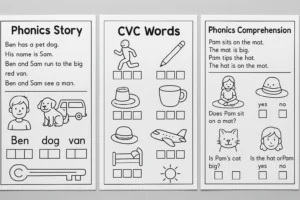
Source: news-leader
The Magic Silent E is a small but powerful letter that changes the way words sound and their meanings. It may be silent, but its influence on words is anything but quiet! The mere addition of the Magic Silent E at the end changes short vowel sounds into long ones, turning “tap” into “tape” and “kit” into “kite.” This simple spelling rule helps young readers and writers comprehend the magic of English words entertainingly and excitingly.
For more details of Phonics Teacher Course Call / Whatsapp +919869866277 / +919869546913
To Download Brochure of Phonics Teacher Course, Click Here!
What is Magic E Called Now?
Split digraph is What Magic E Called Now. Even though the ‘e’ is silent, it works behind the scenes to transform short vowel sounds into long ones.
Understanding the Split Digraph:
- A digraph is when two letters appear together to create one sound (like sh, ch, or th).
- A split digraph occurs when vowels work jointly to form a single sound even though divided by a consonant.
- For instance, in the word ‘take’ – ‘a’ and ‘e’ are vowels separated by the consonant ‘k’, and produce a long “a” sound.
Even though many people still call it Magic E Words understanding the term split digraph can help illustrate how this spelling rule functions in phonics and reading!
Tips for Teaching Silent E
Teaching Magic Silent E Rule can be entertaining and engaging with the proper strategies. Since this letter plays a pivotal role in altering short vowel sounds into long ones, it’s important to use innovative methods that help students grasp the concept effortlessly.
Here are some Tips for Teaching Silent E effectively.
Key Strategies
“Bossy E” Mnemonic
Call the Silent E “Bossy E” because it makes the vowel before it says its name. This catchy phrase helps students remember the rule.
Visual Aids and Charts
Use a chart with word pairs to show how “E rule” changes vowel sounds, such as “kit- kite” or “mad- made.”
Sound Boxes
When breaking Magic E Words into sounds, place the Silent E outside the sound box to show that it doesn’t have a sound but still affects the vowel.
Word Sorting Activities
Have students sort words into two groups: those with short vowels and those with long vowels created by Silent E.
Word Building Games
Let students add or remove Silent E from words to see how their meanings and pronunciations change.
Read Aloud with Silent E Focus
Choose books with many Silent E words and ask students to find and read them aloud.
Pair Practice
Have students take turns reading Silent E words to each other for reinforcement.
Manipulative
Use magnetic letters or letter tiles to physically build words and demonstrate how adding Silent E changes the vowel sound.
“Sneaky E” Story
Tell a fun story about a sneaky “E” that quietly changes words without making a sound.
Important Considerations
Start with Simple Words
Begin with basic word families like “ate,” “ake,” “ape,” etc., before familiarizing more intricate words.
Address Exceptions
Teach students about exceptions like “have” and “were” to avoid confusion.
Multisensory Learning
Include movement, touch, and sound to help diverse learners comprehend the concept.
Regular Practice
Consistently review and practice new Magic E Words to strengthen understanding.
By using these Tips for Teaching Silent E, students can grasp the concept more easily while having fun with words!

Source: freepik
Magic Silent E Word List
The Magic E Word List, an important phonics concept, helps children comprehend how vowel sounds alter in words. This rule enhances reading fluency and improves spelling mastery, making it a vital part of Early Literacy Development.
Understanding the Magic Silent E Rule
The Magic E Word rule follows a simple pattern:
- The silent ‘e’ does not create a sound, but affects the vowel before it, making it articulate its name.
- It usually occurs at the end of a word, altering the articulation and sometimes the meaning.
- Words observing this pattern are part of split digraphs, where the vowel and ‘e’ are separated by a consonant (e.g., bike, rope, flute, etc).
Here is the Magic E Word List with word groups that follow the pattern:
A-E Words (Long A Sound)
- cake, name, gate, plane, snake
- late, made, save, tape, shade
I-E Words (Long I Sound)
- kite, ride, time, fine, slide
- bite, mile, shine, wide, stripe
O-E Words (Long O Sound)
- home, rope, note, bone, stone
- hope, globe, cone, joke, smoke
U-E Words (Long U Sound)
- cute, tune, mule, flute, cube
- rule, fume, brute, use, dune
E-E Words (Long E Sound)
- these, theme, delete, complete, extreme
Teaching phonics effectively requires the right techniques and strategies. Vidhyanidhi Education Society (Govt. Regd.) offers a Phonics Course for Teachers, designed to equip educators with the skills to teach phonics concepts, including the Magic Silent E rule, in an engrossing and methodical way.
Children can acquire strong reading and spelling skills by understanding and practicing Magic E Words, thus building a solid foundation for literacy success.
Empower young minds! Join Vidhyanidhi Education Society’s Phonics Teacher Course today!
For more details of Phonics Teacher Course Call / Whatsapp +919869866277 / +919869546913
To Download Brochure of Phonics Teacher Course, Click Here!
Phonics Teacher Course
FAQs
How to Identify Silent E?
A silent 'e' is usually found at the end of a word, making the vowel before it says its name (long sound), like in "cake" or "bike," but it itself remains silent.
When to Introduce Magic E?
Introduce Magic E after children master short vowel sounds, typically in early reading stages (Kindergarten or 1st grade) to help them recognize long vowel patterns.
Why is It Called Magic E?
It’s called Magic E because it changes the vowel sound without making a sound itself, turning "cap" into "cape" or "hop" into "hope," like a magical spelling trick!



